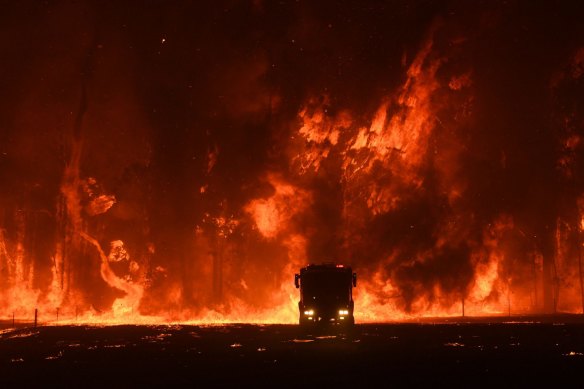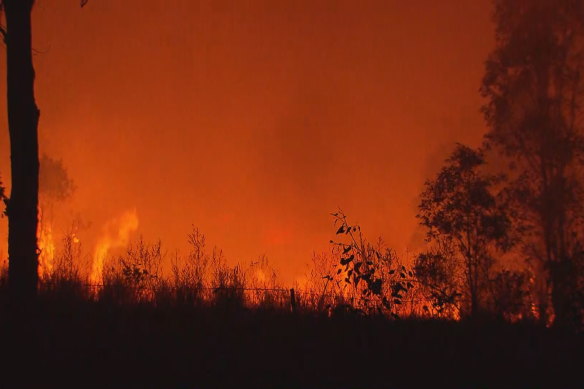This was published 1 year ago
‘People don’t need to die in the heat’: Charts show dire future summer forecasts
By Laura Chung
Extreme heat, bushfire and freezing temperatures have sent more people to hospital in the past 10 years than ever before, as experts warn more needs to be done to protect Australians from the dangers of a changing climate in the coming decades.
There were more than 9110 hospitalisations and 670 deaths related to extreme heat, cold, bushfires and rain between 2012 and 2022, shows a report by the Australian Institute of Health and Welfare, published on Thursday.

A fire crew is overwhelmed at Orangeville, south-west of Sydney, in December 2019. Credit: Nick Moir
Health and climate experts fear these figures will get worse as weather extremes become more frequent and intense.
Already, this year will probably be the hottest in the past 100,000 years as climate scientists warn global temperatures have soared to such an extent that Earth has entered uncharted territory. June, July, August and September were the warmest respective months since records began, with October likely to follow. A strong El Nino is expected to persist until mid-2024 in most forecast models.
Extreme heat, cold and everything in between
Extreme heat is one of the biggest causes of hospitalisations, accounting for 7104 injury hospitalisations and 293 deaths in the 10-year period.
Queensland and Victoria had the highest number of extreme heat hospitalisations between 2019 and 2022, while Victoria also had the most extreme cold hospital admissions.
NSW had the highest number of bushfire and storm hospital admissions during the same time period.
“Evidence has shown that over the past three decades, there has been an increase in the frequency and severity of extreme weather events, such as extreme heat, bushfires, extreme cold, rain and storm-related events, including high rainfall, floods and cyclones,” Australian Institute of Health and Welfare spokesperson Dr Heather Swanston said.
“We are seeing this reflected in hospitalisations and deaths.”
Extreme heat is a killer
The below graph shows deaths per extreme weather, with extreme heat and extreme cold as the main drivers. Heatwave-related deaths peak during severe El Nino years, such as during 2014 and 2016, or 2019 to 2020.
Since 2000, heatwave deaths in Australia have been concentrated in events that largely affected Victoria and South Australia. For example, in January 2009, there were 374 deaths and167 deaths in January 2014 during extreme heatwaves. Those figures are just the ones that we’ve been able to attribute to extreme heat, so it’s likely the true number is a lot higher.
The UN’s World Meteorological Organisation estimated 60,000 people died as a result of heatwaves in Europe alone last year.

Extreme heat is causing thousands of people to be hospitalised.Credit: Nine
Why is the heat so bad?
South Australian emergency medicine specialist Dr Kimberly Humphrey said Australians had adapted to extreme weather, but we were reaching our capacity to do so.
“As climate change progresses, we will see more and more health impacts from extreme weather events. We need to be prepared for things to get worse than they are, things are going to get worse, and we need to prepare for what is coming,” said Humphrey, who is also a member of Doctors for the Environment Australia.
She added that already, healthcare systems were struggling under demands, and extreme weather events often meant hundreds sought help all at once.
Climate Council Research director Dr Simon Bradshaw said the health risks associated with climate change were rapidly intensifying.
“There is still much we can and must do to limit future harms, particularly when it comes to extreme heat,” he said.
“If we substantially reduce our emissions this decade, then from around 2040 we will start to see fewer deadly heatwaves than would otherwise occur.”
Without emission cuts and as climate change worsens, Sydney’s temperature highs could rise from 26.4 degrees to 29 degrees by 2100 – a climate typically experienced in places such as Port Moresby, Papua New Guinea. In Melbourne, temperatures are likely to increase by between 1.2 and 3.1 degrees by 2070.
‘Our cities and homes … are not appropriate for the current climate, let alone the increasingly hot climate.’
Emma Bacon, the founder of Sweltering Cities
Humphrey said heat impacted our heart, lungs and kidney functions, which made it so dangerous. While we were pretty good at regulating heat, our bodies could only take so much before they failed, she said.
Emma Bacon, the founder of Sweltering Cities, an organisation that works with communities in the hottest suburbs to campaign for more liveable and sustainable cities, said this would have dangerous consequences on people’s livelihoods.
“The issue is the way we build our cities and homes. They are not appropriate for the current climate, let alone the increasingly hot climate. There are urban heat areas that are 10 to 15 degrees hotter than other parts of the city,” she said.
“People’s homes aren’t protecting them. We need to acknowledge people should be safe in their homes and retrofit building codes [to make them more heat resilient].”
Bacon added the best place to start would be with those who were most commonly hospitalised due to extreme heat, namely older people, those with disabilities or in the hottest areas, and ensure their homes were first.
“The coming summers will be the hottest of our lives, and it will get worse and worse. It’s something hard to wrap our heads around: that the unprecedented heat we will feel isn’t something we’ve ever experienced before.
“People don’t need to die in the heat.”
Reassuringly, there’s been some movement. For example, councils across the world, including some in Melbourne and Sydney, have hired chief heat or resilient officers who are in charge of ensuring appropriate plans are in place for hot days, or future-proofing cities. But a lot more needed to be done, Bacon said.
Age also matters
The report shows those 65 years and older had a higher number of extreme weather hospitalisations and deaths between 2019 and 2022.
But Bacon said extreme weather isn’t just an age issue.
“Hotter summers have ongoing effects on people. You’ve got different people impacted, you’ve got those who are: older, have disabilities or chronic conditions, and are pregnant,” Bacon said. “Millions of people will be impacted at once.”
A guide to the environment, what’s happening to it, what’s being done about it and what it means for the future. Sign up to our fortnightly Clear Air newsletter here.